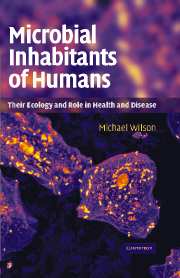Book contents
- Frontmatter
- Contents
- Preface
- Abbreviations used for microbial genera
- 1 An introduction to the human–microbe symbiosis
- 2 The skin and its indigenous microbiota
- 3 The eye and its indigenous microbiota
- 4 The respiratory system and its indigenous microbiota
- 5 The urinary system and its indigenous microbiota
- 6 The reproductive system and its indigenous microbiota
- 7 The gastrointestinal tract and its indigenous microbiota
- 8 The oral cavity and its indigenous microbiota
- 9 Role of the indigenous microbiota in maintaining human health
- 10 Manipulation of the indigenous microbiota
- Index
3 - The eye and its indigenous microbiota
Published online by Cambridge University Press: 06 July 2010
- Frontmatter
- Contents
- Preface
- Abbreviations used for microbial genera
- 1 An introduction to the human–microbe symbiosis
- 2 The skin and its indigenous microbiota
- 3 The eye and its indigenous microbiota
- 4 The respiratory system and its indigenous microbiota
- 5 The urinary system and its indigenous microbiota
- 6 The reproductive system and its indigenous microbiota
- 7 The gastrointestinal tract and its indigenous microbiota
- 8 The oral cavity and its indigenous microbiota
- 9 Role of the indigenous microbiota in maintaining human health
- 10 Manipulation of the indigenous microbiota
- Index
Summary
The eye is a sense organ designed to focus light onto receptor cells and to control the amount of light reaching these receptors. Its optimal functioning requires the presence of certain accessory structures which include the eyebrows, eyelids, eyelashes, and the lacrimal apparatus.
Anatomy and physiology of the eye
The basic anatomy of the eye and its accessory structures are shown in Figure 3.1. The eyeball is approximately 2.5 cm in diameter and is bounded by a white, fibrous, protective layer of connective tissue (the sclera) at the back and by a transparent fibrous layer (the cornea) at the front. Apart from the cornea, the front of the eye is covered by a transparent layer of modified skin (the conjunctiva), which also lines the eyelid. Inside the sclera is a layer of vascular tissue (the choroid), which supplies nutrients to it. The region of the choroid beneath the cornea is modified to form the iris and ciliary body, which are muscular structures involved in controlling, respectively, the amount of light entering the eye and the shape of the lens. The innermost layer of the eye is the retina, which extends back from the ciliary body to cover the rear three–quarters of the surface of the eyeball. The retina contains the light–sensitive cells and has its own blood and nerve supply.
- Type
- Chapter
- Information
- Microbial Inhabitants of HumansTheir Ecology and Role in Health and Disease, pp. 107 - 127Publisher: Cambridge University PressPrint publication year: 2004



